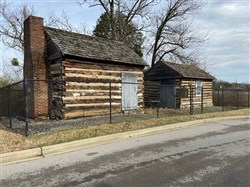VOL. 44 | NO. 4 | Friday, January 24, 2020
Time to end farce of Evergreen Place preservation

The two remaining cabins from the Evergreen Place property served as slave quarters. The logs are damaged from insect infestation and wood rot.
-- Photographs ProvidedThey look out of place because they are, in both setting and time, two forlorn mid-19th century structures inharmoniously situated behind a Region’s Bank and within sight of the Home Depot that created the problem. They’re orphans, log and wood-shingle outbuildings locked behind a chain link fence that’s both protector and prison.
They deserve a better fate. But then, so did their parent structure, Evergreen Place.
If you’ve been around Nashville for a while and pay any attention to historic buildings and their fates, you’re probably familiar with the tale. The home known as Evergreen Place, near the intersection of Briley Parkway and Gallatin Pike, was one of the oldest structures in Nashville. Its earliest portion dated to 1795.
With the help of its owner and the Metro Historic Commission, it was listed on the National Register of Historic Places in 1982. After its time as a residence, it served for about 15 years as the home of the Jim Reeves Museum, honoring one of Nashville’s musical legends.
By 2005, however, it had fallen on a decade of hard times and neglect and been listed by the Tennessee Preservation Trust as one of the “most endangered historic places” in the state.
That turned out to be prophetic.
On Sept. 22, 2005, a developer had Evergreen Place bulldozed despite efforts by the Historic Commission to save it.
“It was a terrible time and I was very frustrated, as you can imagine,” says Tim Walker, now executive director of the Historic Commission and then with the Metro Historic Zoning Commission.
Quite a hubbub arose as a result. A longtime Metro employee who had issued the demolition permit – which was quickly rescinded – was suspended from his job without pay for a couple of weeks.
But despite the controversy, Metro Council declined to authorize an investigation of the matter. A grand jury decided against any charges.
As part of a settlement with Metro to avoid a lawsuit, however, the developer agreed to preserve the two buildings that had escaped the bulldozer. And so they stand now, totally out of context, and not even on their original location, Walker explains.
The demolition and moving destroyed the site’s historical integrity, he adds, and so it was removed from the National Register.
“Also, several years ago our office assessed the condition of the buildings with a historic preservation contractor, and the buildings were found to be in very poor condition with many of the logs damaged by insect infestation and wood rot,” he acknowledges. “The consultant determined that a majority of the logs would need to be replaced in order to maintain the buildings long term, leaving very little of the original fabric of each building.”
Some good did come of the whole mess. The Historic Commission worked with Mayor Bill Purcell and Metro Council to create and adopt legislation to delay demolition of historic resources, Walker says.
“This delay, or ‘cooling off period,’ allows MHC, Council, the administration, and the public to look for solutions other than demolition, and even when the final outcome is demolition, we are able to document the structure and its history for future generations.”
The two cabins were used as slave quarters, an archaeological investigation after the demolition found, but as they stand now, they serve little historical or aesthetic purpose.
I asked Walker what he’d like to see done with them. He declined to say, suggesting it was a decision for the community and the local council member.
“However, as they currently sit, there is minimal access – they are fenced to prevent you from going inside or getting too close, it’s also difficult to get physically close to them as there is no sidewalk or walking path from a parking area to the buildings, and there is very little information on-site or available about the buildings, Evergreen and its history,” he says.
Walker wouldn’t say it, but I will: Find a better place for them or tear them down. At this point, it would be a mercy killing.
Joe Rogers is a former writer for The Tennessean and editor for The New York Times. He is retired and living in Nashville. He can be reached at [email protected]